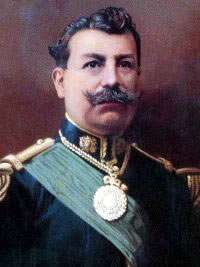Ismael Montes

Ismael Montes Gamboa (5 October 1861 – 16 October 1933) was a Bolivian general and political figure. He served as the President of Bolivia between 1904 and 1909 and once again between 1913 and 1917.
Early life

Born into an affluent land-owning family from the rural department of La Paz in 1861, Montes fought valiantly in the War of the Pacific against Chile and then studied law. Rejoining the active service for the 1899 Civil War, he commanded a number of Liberal/Federalist forces and was appointed Minister of War in the administration of José Manuel Pando. Possessed of an adventurous temperament, he also saw action in the 1903 Acre War against Brazil. Earlier, he had become Pando's hand-picked successor. After he won the 1904 Presidential election, his first term in office was successful. Under the leadership of the Liberal party, the government made large-scale investments in infrastructure projects vital for Bolivia's growing economy, such as in roads and railways which integrated the urban centers of this mountainous country.
More controversially, it fell to Montes to sign the peace treaty with Chile, which had been pending since the War of the Pacific almost 25 years earlier. As a result, Bolivia officially recognized the loss of its entire maritime cost in exchange for a few meaningless concessions and a sum of money. The deal he cut with Chile was unfavorable, but Bolivia had decisively lost the war. Chile was firmly in control of the previously Bolivian territories. Montes felt that his country had little choice on the matter.
Extension of presidency

In 1908, the officialist (Liberal Party) candidate Fernando Guachalla won the Presidential elections, but died of natural causes before the scheduled swearing-in ceremony. This provided Montes with the excuse to invalidate the elections since he did not fully trust Guachalla's Vice-Presidential running mate, Eufronio Viscarra. With the motto "once the tree dies, so do its branches" the President prevailed upon Congress to extend his term by one year pending the calling of fresh elections. This earned him a number of enemies and began to undermine his popularity, but did not prevent the election of a trusted Montes man, Eliodoro Villazón, who took possession in August, 1909.
Villazón's term (1909-1913) had been peaceful and relatively prosperous, at least from the narrow perspective of the mostly-white and creole elites that participated in the running of the country. This prompted Montes to run for re-election in the 1913 presidential contest, a taboo in the largely personalistic world of Bolivian politics. The result was the defection of many Liberals who, 2 years later, would join the Republican Party of former President José Manuel Pando and José Maria Escalier. But Montes was elected in 1913, and his second term was as troubled as his first had been successful. An increasingly assertive opposition (Republicans and Conservatives) agitated for a coup against Montes, and dispossessed peasants and workers demanded more rights. Meanwhile, the economy had deteriorated considerably as a result of the global recession precipitated by the First World War. A curfew had to be invoked on at least one occasion, and various opposition leaders were jailed and exiled.
Final years
Montes was able to finish his second term and in 1917 transferred power to his hand-picked successor, the blue-blooded José Gutiérrez Guerra. Montes remained an influential political figure even after the 1920 revolt that brought to power the Republican Party. He even insisted on being assigned a (largely symbolic) military role at the onset of the Chaco War against Paraguay (1932–35), when he was already in his 70s. He died soon thereafter, in October 1933, aged 72.
| Political offices | ||
|---|---|---|
| Preceded by José Manuel Pando |
President of Bolivia 1904–1909 |
Succeeded by Eliodoro Villazón |
| Preceded by Eliodoro Villazón |
President of Bolivia 1913–1917 |
Succeeded by José Gutiérrez |